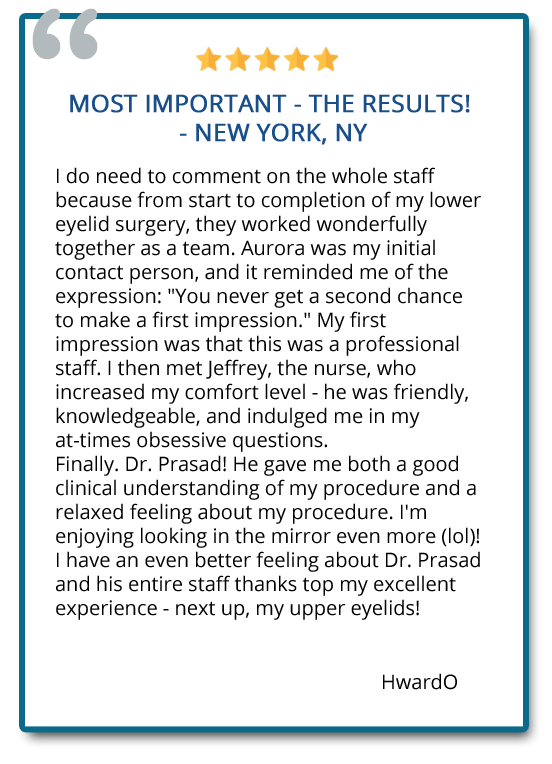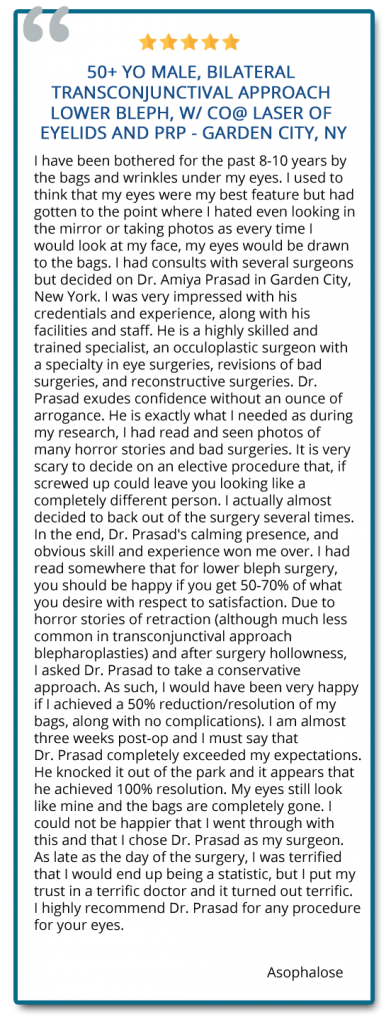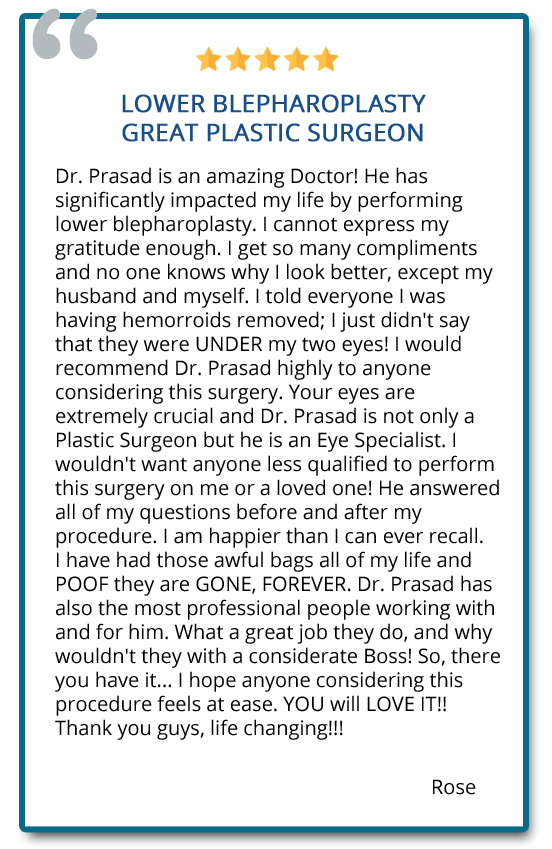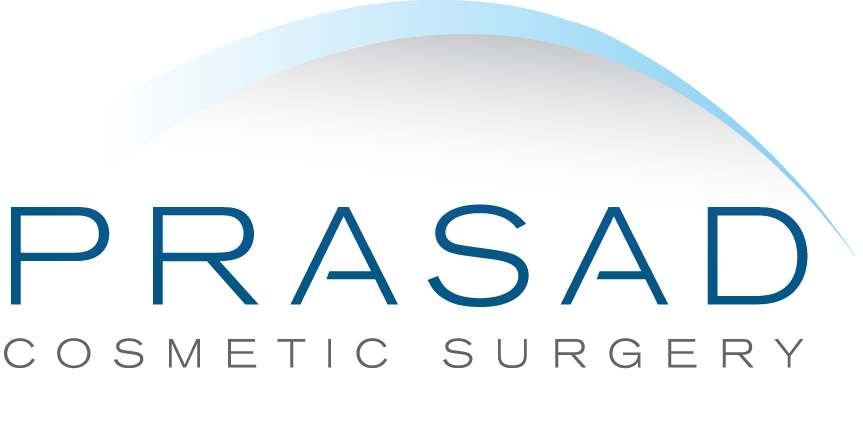Schedule Your Consultation with Dr. Prasad Here
- Home
- About Dr. Prasad
- Face & Eyes
Eyelifts
- Eyelid Surgery NYC
- Eye lift Before and After Photos
- Asian Eyelid Surgery
- Upper Eyelid Surgery
- Upper Eyelid Hollow / Lower Brow Hollowing
- Under Eye Bag Surgery
- Eyelid Ptosis Surgery
- Transconjunctival Blepharoplasty
- Under Eye Fillers
- Eyelid Surgery Revision Specialist
- Thyroid Eye Disease
- Tear Trough Implants
- Eye Lift Questions and Answers
- Body
- Injectables
- Laser
- Hair Restoration
- Photos
- Hair Restoration Before and After Photos
- Eye lift Before and After Photos
- Upper Blepharoplasty Before and After
- Ptosis Surgery Before And After
- Facelift Before and After Photos
- Lip Enhancement Before and After Photos
- Under Eye Filler Before and After
- Blepharoplasty Before and After
- Lower Blepharoplasty Before and After Photos
- Eyelid Surgery Before and After
- Double Eyelid Surgery Before and After
- Contact Us
- Home
- About Dr. Prasad
- Face & Eyes
Eyelifts
- Eyelid Surgery NYC
- Eye lift Before and After Photos
- Asian Eyelid Surgery
- Upper Eyelid Surgery
- Upper Eyelid Hollow / Lower Brow Hollowing
- Under Eye Bag Surgery
- Eyelid Ptosis Surgery
- Transconjunctival Blepharoplasty
- Under Eye Fillers
- Eyelid Surgery Revision Specialist
- Thyroid Eye Disease
- Tear Trough Implants
- Eye Lift Questions and Answers
- Body
- Injectables
- Laser
- Hair Restoration
- Photos
- Hair Restoration Before and After Photos
- Eye lift Before and After Photos
- Upper Blepharoplasty Before and After
- Ptosis Surgery Before And After
- Facelift Before and After Photos
- Lip Enhancement Before and After Photos
- Under Eye Filler Before and After
- Blepharoplasty Before and After
- Lower Blepharoplasty Before and After Photos
- Eyelid Surgery Before and After
- Double Eyelid Surgery Before and After
- Contact Us
Transconjunctival Blepharoplasty
Eyelid surgery, or blepharoplasty, consistently ranks as one of the most popular facial cosmetic surgery procedure in the United States. Transconjunctival blepharoplasty is a type of eye bag surgery, which is performed without any external incisions. When expertly performed, the eyes look completely natural without any visible sign of surgery such as scars or the “over-pulled” look.
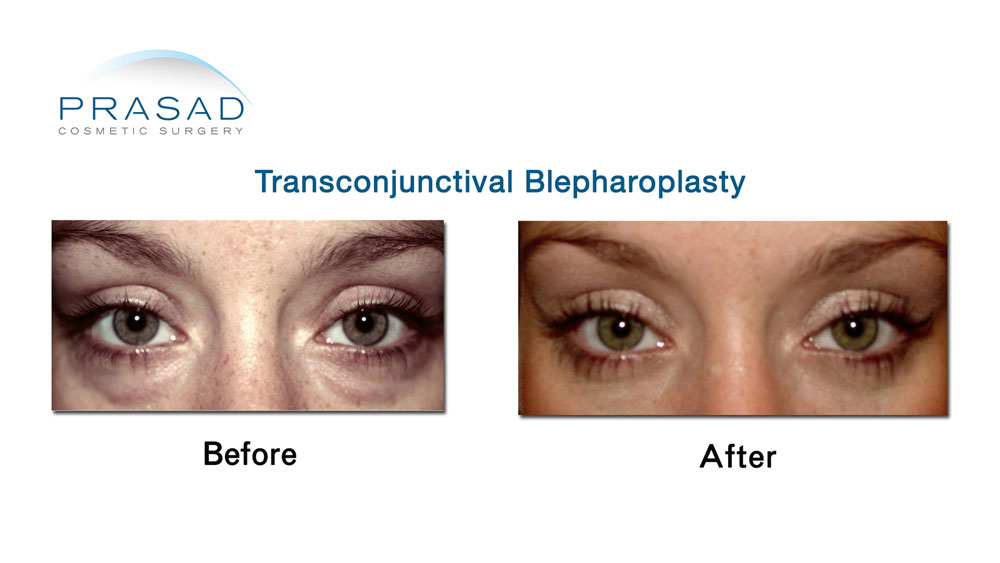
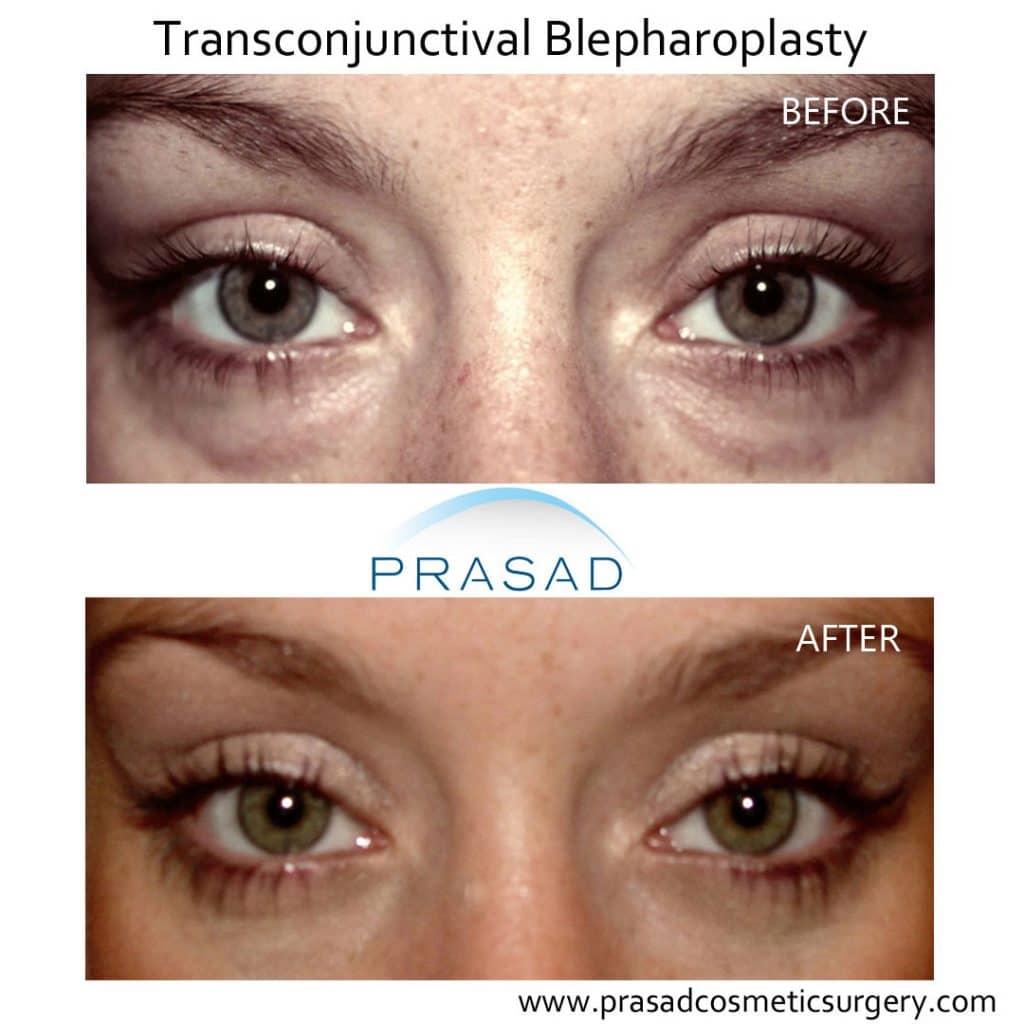
What is Transconjunctival Blepharoplasty?
A lower Blepharoplasty can be done from either an external (transcutaneous or “through the skin”) approach or an internal (transconjunctival or “through the conjunctiva”) approach. Dr. Amiya Prasad is an expert at performing both types of lower eyelid blepharoplasty
The eyelids are composed of delicate layers of tissue including skin and muscle. The eyelids are intimately related to the eye and the bone structure around the eye called the “orbit”. Fat pockets which are part of the orbit can prolapse or herniate forward resulting in under eye bags.
Transconjunctival blepharoplasty is method of improving the appearances of eye bags which have herniated forward, from behind the eyelid without any external scar.
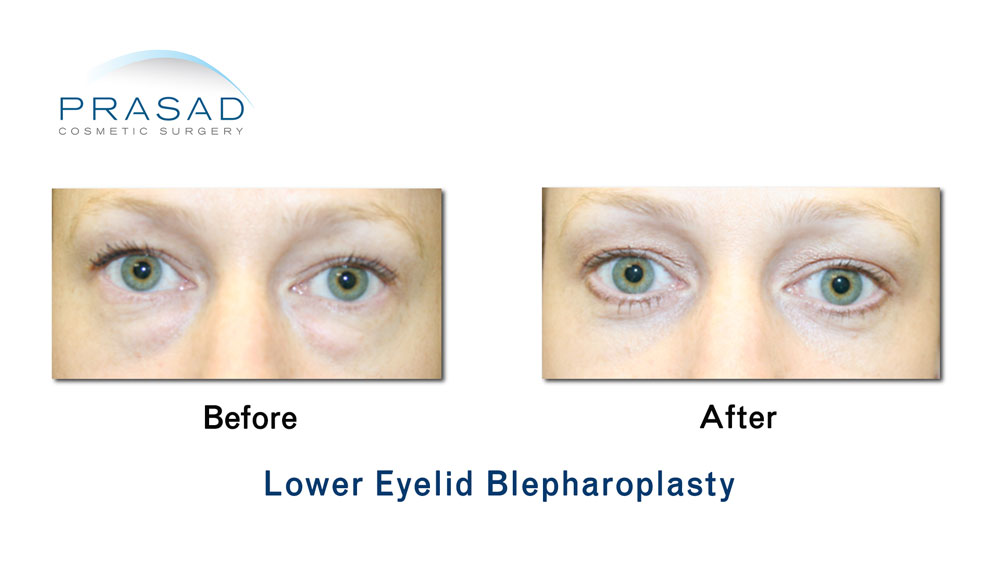
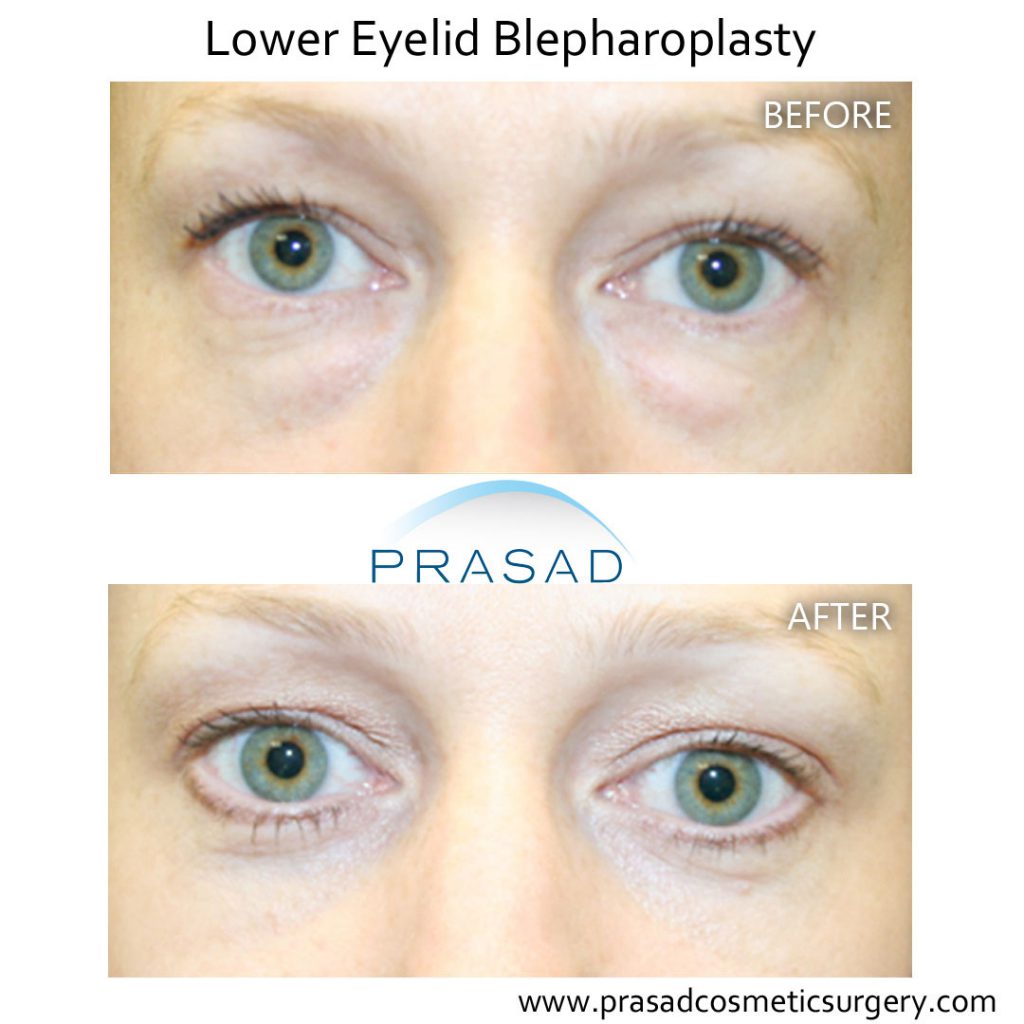
Eye Bags Causes
The eyes convey emotion and non-verbal communication. Weary looking eyes can often convey the wrong feeling or message. The problem of puffy or enlarged under eye bags is frequently a genetic issue. This means that younger patients, even as early as in their teens, can be candidates for lower eyelid blepharoplasty.
The cause of puffy eye bags is the naturally occurring fat pockets around the eyes pushing forwarded and creating a bulge (AKA lower eyelid fat prolapse, or herniated fat). Frustrated with buying creams that don’t work, many people contact us to know how to get rid of puffy eyes.
Very often, remarks about looking tired, weary, and lacking energy are based primarily on the appearance of the eyes. Comments about “looking tired” even when well-rested is one of the most common reasons for inquiring about eyelid procedures.
Candidates for Transconjunctival Blepharoplasty
Lower eyelid surgery or lower eyelid blepharoplasty performed through a transconjunctival approach is very popular at Prasad Cosmetic Surgery. The cost of this surgery is less than many facial procedures and can have a dramatic impact on your appearance. You may be a candidate for Transconjunctival Blepharoplasty if:
- you have lower eye bags
- look tired
- good lower eyelid muscle and skin tone
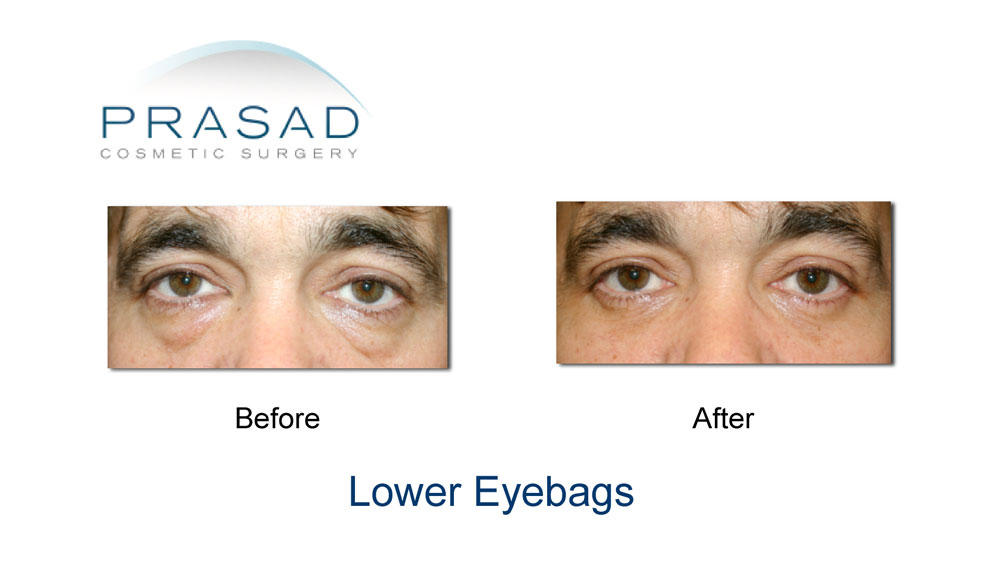
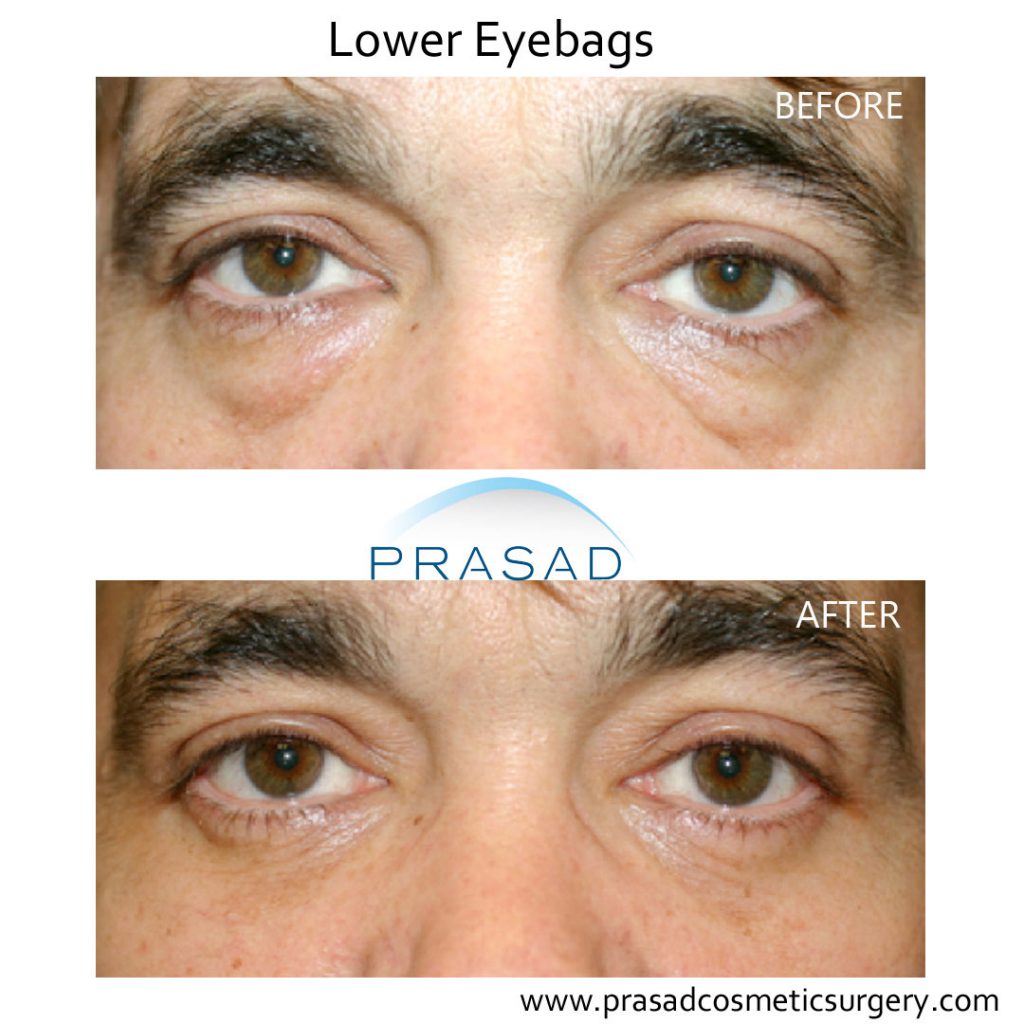
Benefits Of Transconjunctival Blepharoplasty
The goal of a blepharoplasty is to maximally rejuvenate the eyes with long-lasting results. Although many surgeons write about specific techniques, each patient is different and the eyelid rejuvenation plan has to be customized for you. The Transconjunctival incision offers various benefits compared to traditional lower eyelid surgery:
- No outside scars
- The eye shape is better preserved
- Faster recovery
- Less trauma around the eyes
- Reduced bruising and swelling
How is the procedure done?
It’s important to understand that lower eyelid surgery is complex, and a great deal of finesse is required in order to maintain the right support to the area and not change the shape of the eye.
During the procedure, the lower eyelid is approached from the inside and the fat pockets are sculpted and repositioned. One of the advantages of this approach is that the eyelid is not approached from the skin side or from the front which makes it more precise to gauge the effect of fat sculpting as the operation progresses.
Dr. Prasad evaluates the results throughout the procedure to make sure that the shape and contour of the eyes are created as desired. If needed, Dr. Prasad may also tighten any loose skin after the fat is removed. This process usually involves the use of lasers such as the fractional CO2 laser. This method typically results in quicker recovery when compared to the transcutaneous (external approach) blepharoplasty.
Dr. Prasad performs transconjunctival blepharoplasty under local anesthesia with LITE IV sedation (twilight anesthesia) so there is no need for general anesthesia.
To improve the eyelid skin quality and dark circles in some patients, Dr Prasad will often use PRP ( platelet-rich plasma) which is derived from the patient’s blood. The platelets which are important cells for healing and many growth factors are separated from the plasma by centrifugation. The PRP is then placed under the skin to improve the skin quality and the appearance of dark circles.
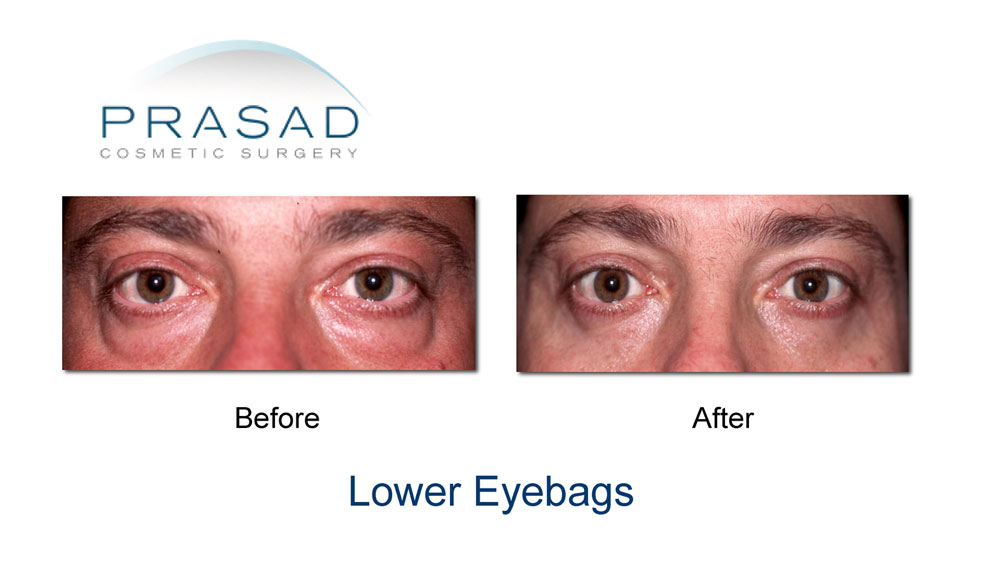
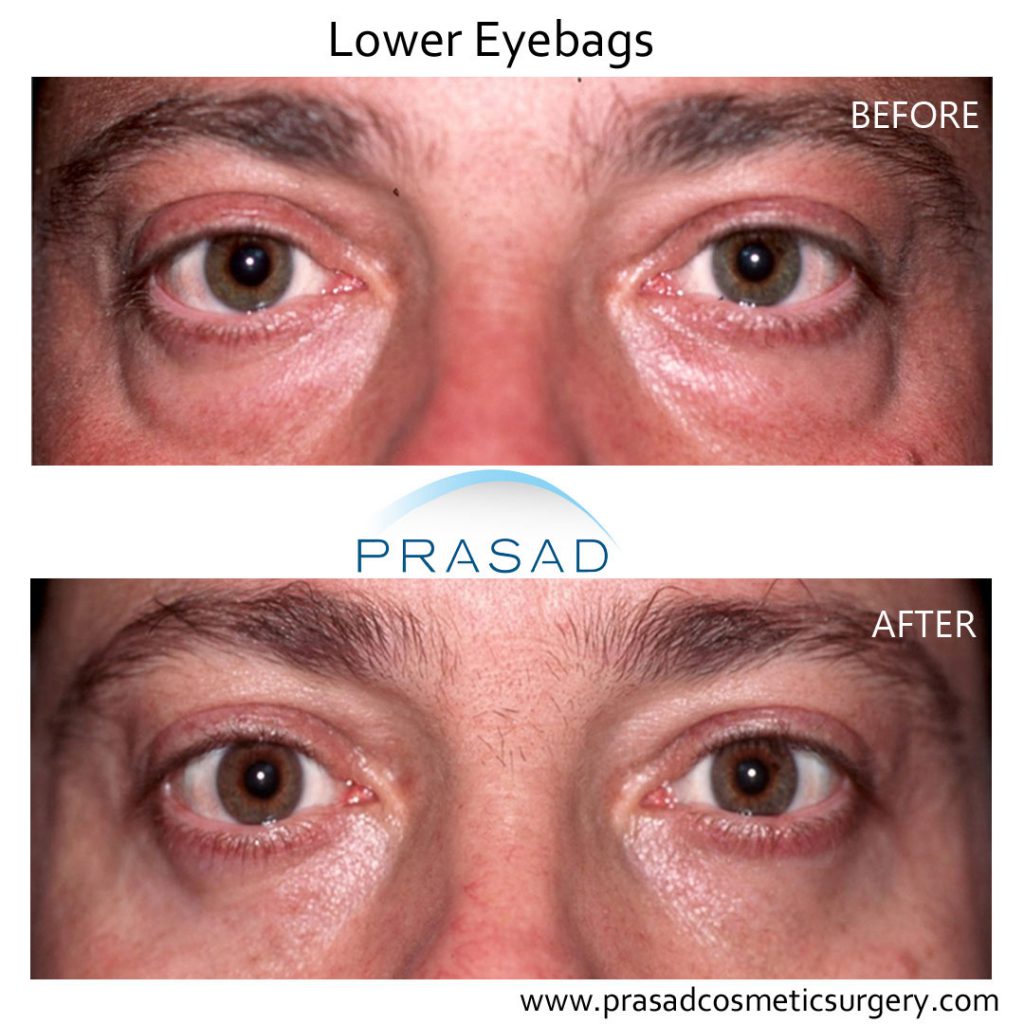
Quick recovery
Dr. Prasad is a pioneer in performing eyelid surgery such as transconjunctival blepharoplasty with local anesthesia with IV sedation. Using local anesthesia with IV sedation means that patients do not have to be put under general anesthesia.
Advantages of this technique is that patients:
- recover from surgery faster,
- have faster surgery time
- have less bruising
- avoid the complications associated with
- general anesthesia (being unconscious and breathing through a respirator).
Dr. Prasad trademarked his Quick Recovery technique using LITE™ IV sedation – a combination of local anesthesia with IV sedation to make his patients comfortable during their procedure.
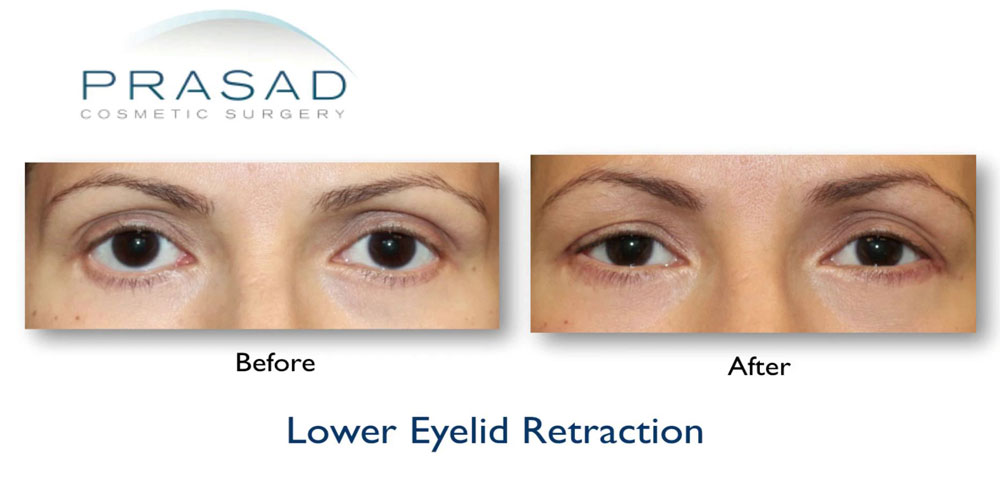
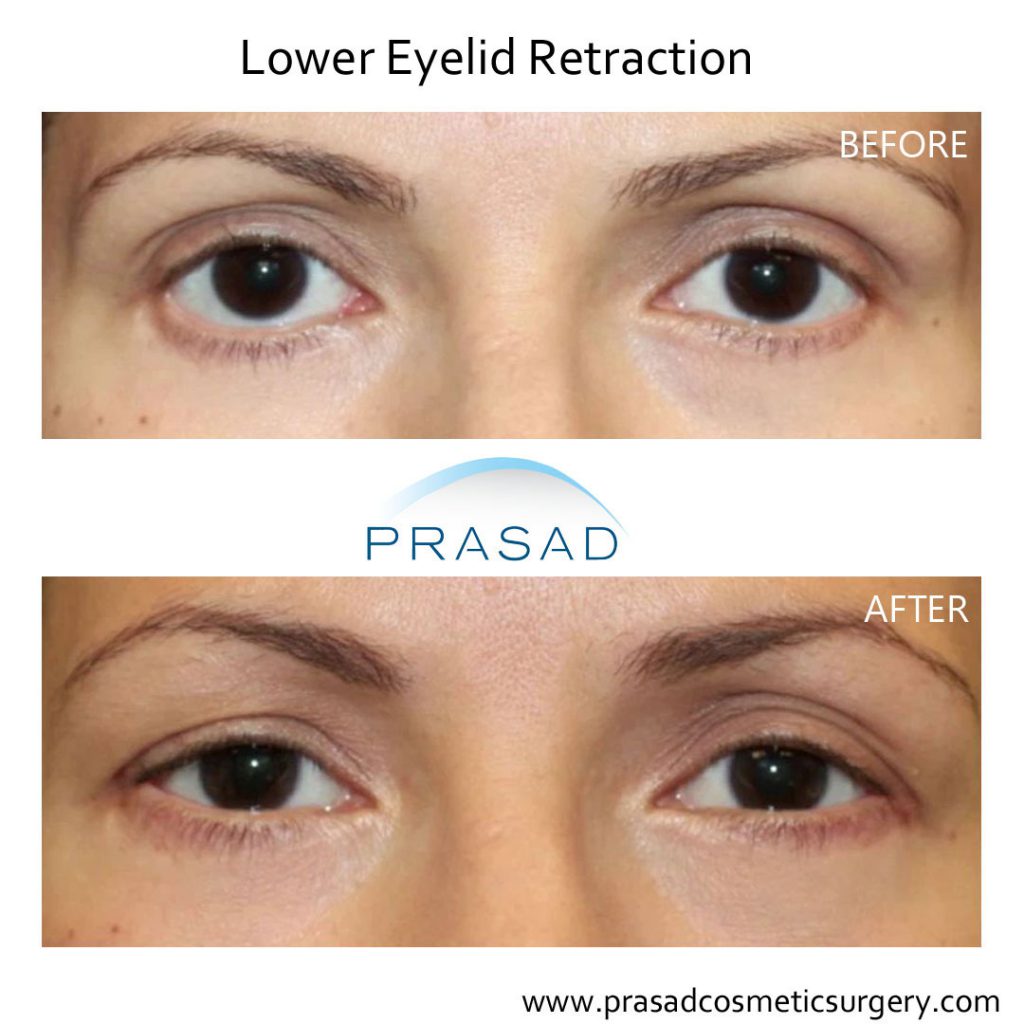
Fat Repositioning with Lower Eyelid Surgery
Dr. Prasad doesn’t recommend or perform repositioning of orbital fat into hollow areas of the lower orbital rim. This procedure called lower eyelid fat repositioning or lower transpositioning is prone to complications such visible swelling due to sutures keeping repositioned fat in place, that also cut off the fat from its blood supply. Dr. Prasad usually recommends hyaluronic filler for adjacent hollow areas as fillers do not require a connection to a blood supply.Personalized Eye surgery
Transconjunctival blepharoplasty is a type of eyelift surgery that is performed for people of all ethnic backgrounds. It is performed to improve the appearance of bags and loose skin under the eyes. Puffy eyes are frequently caused by bulging fat pockets in the lower eyelids. Dr. Prasad performs transconjunctival laser blepharoplasty to sculpt this fat. This procedure is performed internally, producing no outside scars and preserving the natural shape of the eye. This 53-year-old woman from South America was accustomed to always looking young but was noticing how she was looking older because of the appearance of her eyes. Frustrated with applying makeup to hide the bags under her eyes, she came to Dr. Prasad and underwent lower eyelid transconjunctival blepharoplasty. She appreciated Dr. Prasad’s familiarity with the concerns people of all skin types in terms of scars and keloids. Dr. Prasad specializes in lower and upper eyelid surgery for all ethnic skin types and was one of the first Oculoplastic Surgeons to teach about the unique needs of people of different ethnic backgrounds.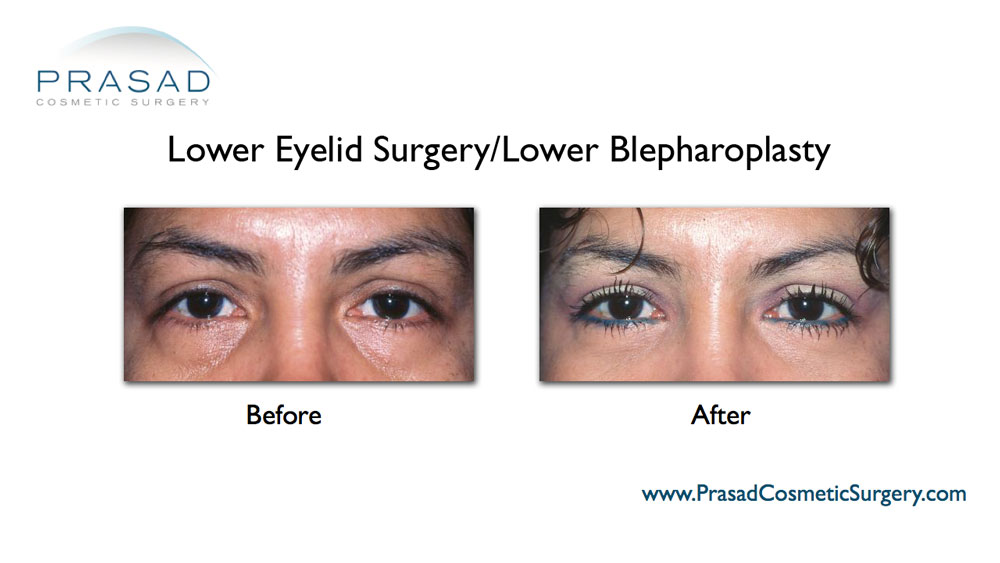
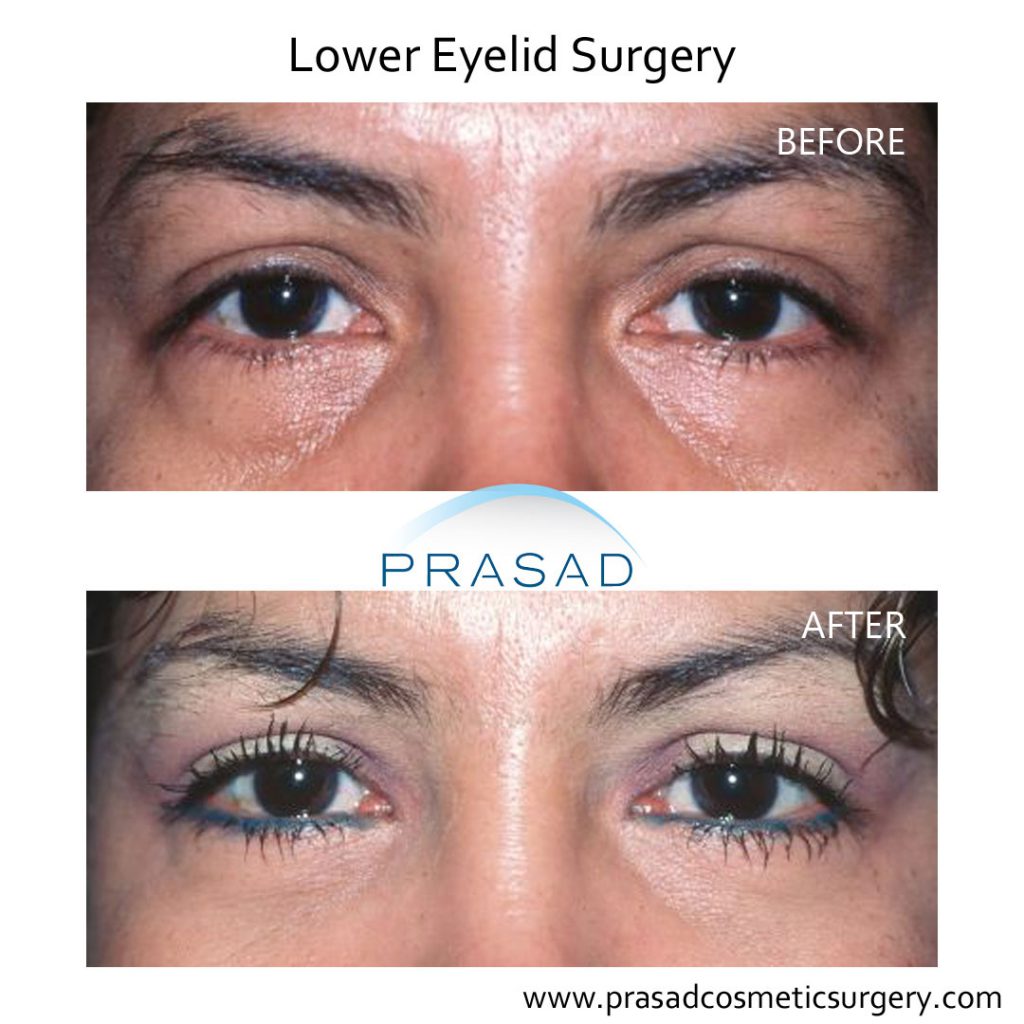
Blepharoplasty for Older Patients
While most surgeons believe transconjunctival blepharoplasty is only appropriate for younger patients with no excess eyelid skin, this procedure can can work well for older patients. Many older patients with large eye bags are concerned that once the fat is addressed, the skin would droop and sag.
As Dr. Prasad explains, “the eyelid is supported by the orbicularis oculi muscle which acts like a belt, and can tighten the lower eyelid skin once fat has been removed. This muscle can be active in older patients – even when a considerable amount of fat has been removed, the orbicularis muscle can tighten the loose skin”.
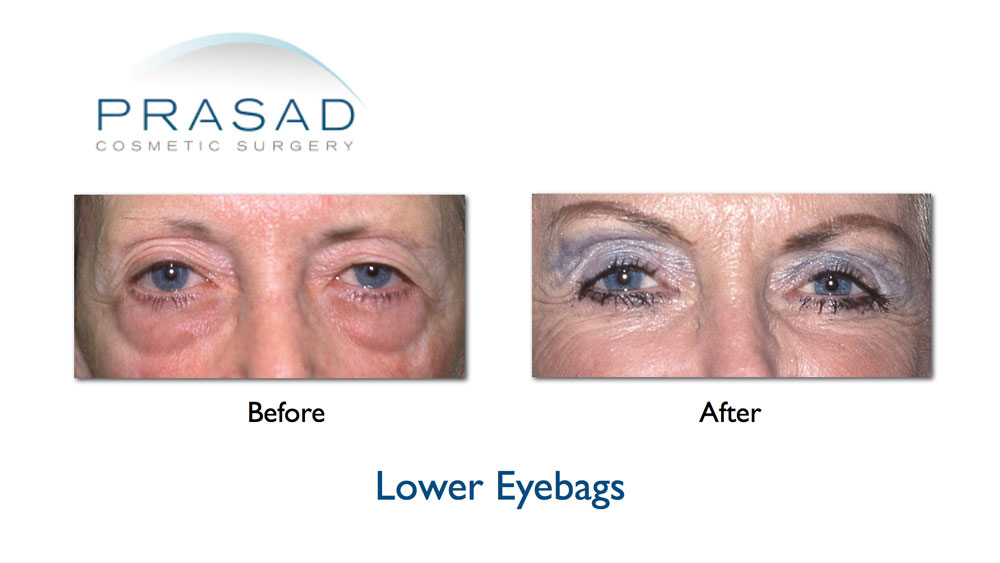
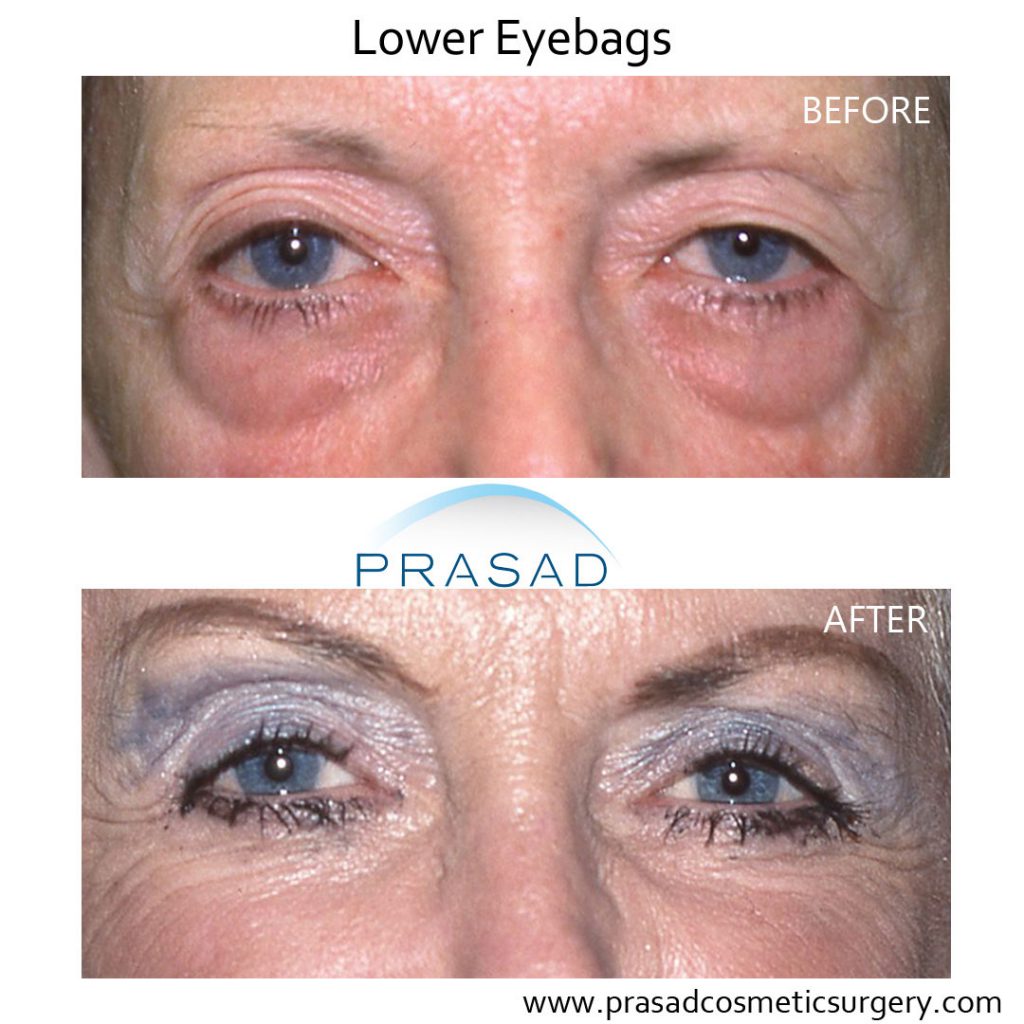
Does non-surgical option for eyebags works?
Unfortunately creams cannot treat eyebags caused by herniated fat. Since these enlarged fat pockets are underneath the skin, topical creams, ointments and other non surgical treatments are ineffective.
While the use of non-surgical fillers can temporarily treat select cases of puffy eyes by camouflaging the bulges of fat, the best candidates for this type of procedure have minimal fat prolapse. Under eye filler are temporary and in many situations, the bruising from fillers may last longer than the minimal bruising seen in Dr. Prasad’s surgery. Very often, fillers are used by non surgical doctors in a way which cause eye bags to appear even larger. Dr. Prasad is often consulted to dissolve or remove these fillers when events like this occur.
Transconjunctival Blepharoplasty Cost
The cost of transconjunctival blepharoplasty is based on (1) surgeon’s fee, (2) anesthesia fee, (3) facility fees, and (4) extensiveness of the surgery. Dr. Amiya Prasad performs his surgeries at a state-of-the-art surgical facility to provide the highest level of safety for his patients. Financing options are also available.
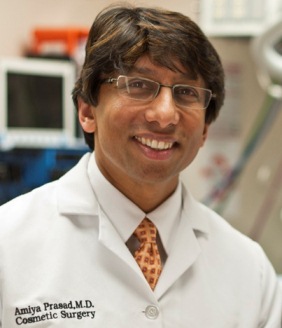
Super-Specialist and Artistry for the Eye Area
Choosing an Oculofacial Plastic Surgeon
Dr. Amiya Prasad has the rare specialty among cosmetic surgeons titled as an Oculoplastic / Oculofacial Plastic Surgeon. This super-specialty of being an Oculofacial Plastic Surgeon (ophthalmic plastic and reconstructive surgeon) involves being trained as a facial cosmetic surgeon as well as an ophthalmologist. Further, Dr. Prasad performs full body cosmetic surgery and is a Diplomate of the American Board of Cosmetic Surgery.
He routinely performs facial cosmetic procedures such as facelift, necklift, browlift (view Brow Lift Before and After Photos), cheek implant and chin implant. This expertise, along with Dr. Prasad’s unique artistic and natural aesthetic style, has made him a highly sought after eyelid specialist in New York and around the world.
Being a leading Oculofacial Plastic Surgeon has also brought many patients who had eyelid surgery performed elsewhere to Dr. Prasad for revision and correction. Patients who have had too much eyelid skin removed by other doctors, resulting in drooping eyes, or worse having eyelids with impaired function, come from all over the world to have their eyelids reconstructed by Dr. Prasad.
Patient Reviews Transconjunctival Blepharoplasty
